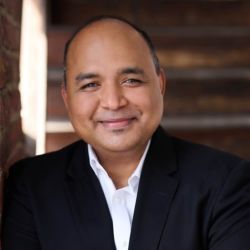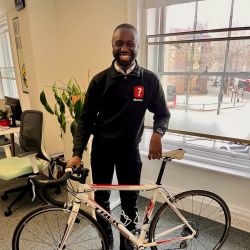Share

Create the Future
City Skylines With Roma Agrawal
Often considered to be the world’s first skyscraper, the Home Insurance Building was completed on 1 March 1885, on the corner of Adams and LaSalle Street in Chicago. At 138 feet (42m) high, it wasn’t the tallest building in Chicago at the time – but its historical significance stems not from its height, but its engineering.
Made possible by several technological breakthroughs at the time, the Home Insurance Building differed from traditional construction methods by using a structure made from iron and, more importantly, steel. This gave it a unique architecture and weight-bearing frame. Compared to previous building designs – which had reached a practical height limit to avoid their weight-bearing masonry walls getting too thick and heavy – this new design proved lighter, stronger, and a more practical way to increase height.
Though there is debate over whether the Home Insurance Building was “the first skyscraper”, or indeed the first to use a steel frame, a combination of other factors helped it to popularize the idea. It provided a template for the second and third generation skyscrapers surrounding us today; it enabled, over a century later, the myriad of unique city skylines we now see around the world.
London’s skyline, in particular, has seen immense change over the centuries. Today, you need only turn your head to see yet another iconic structure towering above you: the “Walkie-Talkie”, “Gherkin”, or “Cheesegrater” for example. But with the number of skyscrapers continuing to grow, how do we future proof them to account for people’s needs decades or centuries into the future? How do we ensure that they complement their surroundings while still encouraging innovation? On what metrics do we define a good or successful structure?
We answer these questions in this episode of Create the Future with Roma Agrawal, a structural engineer who spent six years working on one of London’s most recent and distinctive additions: the Shard. We also speak to Roma about her work promoting engineering as a career, why female representation in engineering varies so significantly around the world, and what it was like to be photographed by Annie Leibovitz alongside Emma Thompson and Rita Ora.
New episodes of ‘Create the Future: An Engineering Podcast’ every other Tuesday. www.qeprize.org/podcasts
More episodes
View all episodes

31. The Future of Fire Safety
28:42What does the UK national anthem have to do with fire safety? And who is responsible for preventing fires of the future?Guru Madhavan - senior director of programs of the US National Academy of Engineering - chairs his first edition of Create The Future. His red hot guests are structural fire engineering expert Professor Luke Bisby, and fire safety engineer Professor Jose Torero Cullen.Follow @QEPrize on Twitter, Instagram, and Facebook for more info.New episodes - conversations about how to rebuild the world better - every other Friday.
30. The Future Of Sports Engineering
26:57Have you ever paused to think about the maths, physics, and engineering behind your favourite piece of sporting equipment? Be it BMX, football boot, shuttlecock, or snowboard?Could engineers be the driving force behind the new sports of the future? What is Sports Engineering anyway?!George Imafidon - Extreme E race engineer - kicks-off a conversation with:Godfather of Sports Engineering Steve Haake, and Editor of Sports Engineering journal Thomas Allen.Follow @QEPrize on Twitter, Instagram, and Facebook for more info.New episodes - conversations about how to rebuild the world better - every other Friday.
29. The Future of Space Telescopes
31:54Space telescopes don't just observe space, they’re located in space. The Hubble Telescope (1990) and the James Webb Space Telescope (2021) marked major turning points in our quest to unravel the mysteries of the universe. So just how big, how far, how powerful can the next telescopes go?Host Roma Agrawal zooms into this topic with the help of:Garth Illingworth, recipient of the 2016 American Astronomical Society Lancelot M. Berkeley New York Community Trust Prize for his work on the most-distant galaxies viewed with Hubble.Jonathan Lunine, part of the science team for the James Webb Space Telescope.New episodes - conversations about how to rebuild the world better - every other Friday.Follow @QEPrize on Twitter, Instagram, and Facebook for more info.
28. The Future of Cameras
33:01Cameras are so integrated into our existence - via smart phones - that it's easy these days to give them little thought. But the technology is changing - and fast. From AI-powered cameras to 3D imaging and virtual reality experiences, the possibilities are endless.Roma Agrawal hosts a snappy conversation to get a snapshot of the future with:Geoff Belknap, historian of photography and Keeper of Science & Technology at National Museums Scotland.Abhijeet Ghosh, professor of Graphics & Imaging at Imperial College London.New episodes - conversations about how to rebuild the world better - every other Friday.Follow @QEPrize on Twitter, Instagram, and Facebook for more info.
27. The Future of Repairs
32:43Do you know how to fix a kettle? Or your smartphone? Or a lightsaber, for that matter?Professor Mark Miodownik (UCL Mechanical Engineering) believes we urgently need a "repairability revolution" to reduce the vast quantities of electrical and electronic waste produced each year. He chats to host Roma Agrawal MBE.Follow @QEPrize on Twitter, Instagram, and Facebook for more info.New episodes - conversations about how to rebuild the world better - every other Friday.
26. The Future (& History) of Time & Watchmaking
23:59The invention of timepieces was arguably more significant for humanity than the printing press or the wheel. So, how has timekeeping evolved over 40,000 years? How has it shaped society? And how will we keep track of time when our species starts to live on Mars?Do make time for this whistle-stop journey through the evolution of time-telling. Watchmaker and historian Rebecca Struthers, author of 'Hands of Time' speaks to host Roma Agrawal MBE.Follow @QEPrize on Twitter, Instagram, and Facebook for more info.New episodes - conversations about how to rebuild the world better - every other Friday.Photography by Andy Pilsbury.
25. The Future Of Motorsports Engineering
39:24What innovations from F1 impact our daily lives? Just how far can engineers push race cars? Is the motorsport industry the fastest and most effective R&D lab in the world?Our podcast host George Imafidon is a Performance Engineer with Team X44, Sir Lewis Hamilton's electric race team, as well as a board member at The Hamilton Commission.Joining George for a pitstop and a chat are:Wavey Dynamics' Jahee Campbell- Brennan, an Automotive Engineer.Dr Kit Chapman, science historian and author of "Racing Green: How Motorsport Science Can Save the World".New episodes - conversations about how to rebuild the world better - every other Friday.Follow @QEPrize on Twitter, Instagram, and Facebook for more info.
24. The Future Of Green Hydrogen
35:51Made exclusively with renewable power, green hydrogen is emerging as a promising alternative to polluting fossil fuels. Is green hydrogen the fuel of the future? And what are the potential pitfalls?Joining host George Imafidon are:Caroline Hargrove, CTO for Ceres Power, who were awarded the 2023 MacRobert Award by the Royal Academy of Engineering for "ground-breaking fuel cell technology that promises to make a major contribution to decarbonising the world at the scale and pace required to save the planet."Michaela Kendall, co-founder of fuel cell pioneers Adelan, and UK Hydrogen Champion for Mission Innovation at BEIS.New episodes - conversations about how to rebuild the world better - every other Friday.Follow @QEPrize on Twitter, Instagram, and Facebook for more info.
23. The Future Of Airports
29:14Is there a foolproof way of ensuring your checked baggage doesn't get lost in transit? How might drones revolutionise air travel? How long until the UK embraces Vertiports for electrical vertical take-off?Mohammad Taher aka Mo T aka The Airport Guy is an Aerodrome Systems Engineer at Heathrow. He discloses some airport secrets to host George Imafidon. Fasten your seatbelts, sit back, and enjoy the ride ...New episodes - conversations about how to rebuild the world better - every other Friday.Follow @QEPrize on Twitter, Instagram, and Facebook for more info.